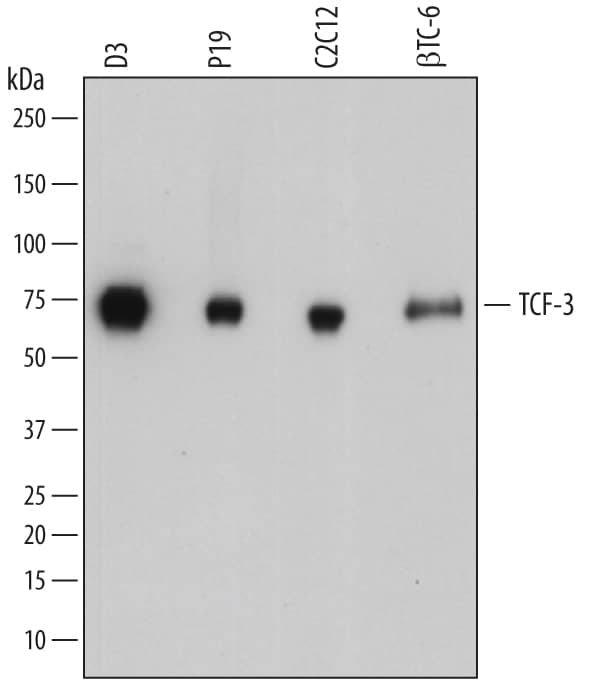Mouse TCF-3/E2A Antibody
R&D Systems, part of Bio-Techne | Catalog # AF7650

Key Product Details
Species Reactivity
Applications
Label
Antibody Source
Product Specifications
Immunogen
Asn33-Arg159
Accession # P15806
Specificity
Clonality
Host
Isotype
Scientific Data Images for Mouse TCF-3/E2A Antibody
Detection of Mouse TCF‑3/E2A by Western Blot.
Western blot shows lysates of D3 mouse embryonic stem cell line, P19 mouse embryonal carcinoma cell line, C2C12 mouse myoblast cell line, and betaTC-6 mouse beta cell insulinoma cell line. PVDF membrane was probed with 0.5 µg/mL of Sheep Anti-Mouse TCF-3/E2A Antigen Affinity-purified Polyclonal Antibody (Catalog # AF7650) followed by HRP-conjugated Anti-Sheep IgG Secondary Antibody (Catalog # HAF016). Specific bands were detected for TCF-3/E2A at approximately 70-75 kDa (as indicated). This experiment was conducted under reducing conditions and using Immunoblot Buffer Group 1.Applications for Mouse TCF-3/E2A Antibody
Western Blot
Sample: D3 mouse embryonic stem cell line, P19 mouse embryonal carcinoma cell line, C2C12 mouse myoblast cell line, and betaTC‑6 mouse beta cell insulinoma cell line
Formulation, Preparation, and Storage
Purification
Reconstitution
Formulation
Shipping
Stability & Storage
- 12 months from date of receipt, -20 to -70 °C as supplied.
- 1 month, 2 to 8 °C under sterile conditions after reconstitution.
- 6 months, -20 to -70 °C under sterile conditions after reconstitution.
Background: TCF-3/E2A
TCF-3 (Transcription factor 3; also Transcription factor A1 and E2A/alpha plus E12/E47) is a 68-75 kDa nuclear class I member of the bHLH family of molecules. It should not be confused with TCF-3, otherwise known as TCF7-L1, an epidermis-associated beta-catenin regulator. TCF-3 is ubiquitously expressed, and generally serves as a transcriptional regulator. It is able to form covalent homodimers, and following phosphorylation, heterodimers with tissue-specific class II bHLH factors, thus impacting the proliferation and differentiation of select cell types. While heterodimers, and possibly homodimers, activate genes by binding to E boxes, heterodimers involving Id proteins are gene repressors. Mouse TCF-3/E12 is 651 amino acids (aa) in length. It contains one Leu-zipper motif (aa 387-422) plus a bHLH domain (aa 544‑604). TCF-3 contains at least three potential Ser phosphorylation sites. There is one alternative splice form that is termed E47 and shows a 69 aa substitution for aa 527-598. This involves the bHLH domain, and it is believed that each splice form has a distinct function(s). Both splice forms (E12 and E47) do occur simultaneously in the same cell type. Over aa 33-159, mouse TCF-3 shares 94% and 75% aa sequence identity with rat and human TCF-3, respectively.
Long Name
Alternate Names
Gene Symbol
UniProt
Additional TCF-3/E2A Products
Product Documents for Mouse TCF-3/E2A Antibody
Product Specific Notices for Mouse TCF-3/E2A Antibody
For research use only
